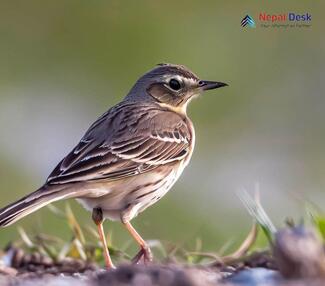Boasting a wealth of biodiversity and awe-inspiring natural scenery, Nepal is nothing short of a paradise for bird enthusiasts. One enchanting yet often overlooked gem among the plethora of bird species here is the American Pipit (Anthus rubescens). This tiny migratory songbird may not catch your eye immediately, but its unique charm has managed to captivate birdwatchers of all levels. First described by Marmaduke Tunstall in 1771, this bird was initially thought to be a type of water pipit. Known as the "American pipit" in North America and the "Buff-bellied pipit" in Eurasia, it shares a close relationship with both the European rock pipit (A. petrosus) and the water pipit (A. spinoletта). So let's delve deeper into the intriguing world of this fascinating avian:
Adaptive Dwellings and Distinctive Traits
The American Pipit's exceptional adaptability in selecting habitats is truly admirable. In Nepal, you can spot these birds in diverse settings such as meadows, grasslands, or even rocky mountain slopes. This adaptability makes them an exhilarating species to observe whilst traversing through Nepal's splendid landscapes.
These medium-sized songbirds possess a svelte figure and brownish-grey plumage that seamlessly integrates them into their environments. Their most eye-catching attributes include a white ring around their eyes and white outer tail feathers that beautifully contrast with their understated tones. Moreover, their signature call—a sequence of high-pitched notes followed by a trill—makes them easy to identify even when disguised by surrounding terrain.
Migratory Patterns and Importance for Conservation
As long-distance travelers, American Pipits journey between North America's summer nesting regions and Asia's winter homes. Nepal holds great importance during these incredible voyages by offering an abundance of suitable rest stops for these birds to recuperate and refuel.
This migratory event not only thrills bird lovers in Nepal but also emphasizes the need for conscientious environmental stewardship. Conserving natural habitats along migration routes for birds such as the American Pipit is critical in maintaining global biodiversity.
Tips for Locating the American Pipit in Nepal
Here are some valuable suggestions to help you find this captivating species across Nepal's varied landscapes:
- Timing is vital: The American Pipits generally migrate through Nepal during October-November and March-April. Plan your trip accordingly to increase your chances of spotting them.
- Pick the perfect spot: Look for open spaces with short grass or rocky slopes at higher elevations, which these birds prefer as resting and foraging grounds.
- Be vigilant: Keep an eye on ground-level vegetation and listen carefully for their distinct calls while hiking or strolling in their preferred habitats.
- Gear up: A high-quality pair of binoculars and a field guide will greatly enhance your birding experience.
In a nutshell, while the American Pipit may not be the most vibrant bird found in Nepal, its elegance and charm mustn't be underrated. The rare opportunity to witness this little songbird against the backdrop of Nepal's stunning landscapes is an unparalleled experience that every bird aficionado will cherish. So, get ready to embark on an unforgettable adventure exploring the mesmerizing realm of the American Pipit in Nepal.




